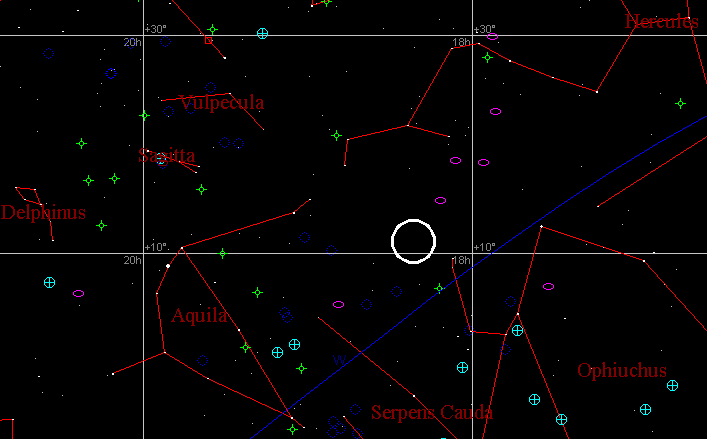On August 13, 1994 Donald E. Machholz discovered a new short periodic
comet with a period of approximately 5,23 years. Shortly after the discovery it was
realised that the comet has recently (within years) split up into a number of fragments.
The comet passed perihelion at 0,75AE on September 18, 1994 and passed descending node
at October 4.
Earth reached this point some 55 days later on November 28, 1994 at 14h UT at a distance
of 0,186 AE at the outside of the comets orbit. This distance is too large for high
meteor activity, but some particles could enter the earth atmosphere.
The computed position of the Radiant is situated near the triple-point Ophiuchus-Hercules-Aquila
roughly at about RA 18h30m; DC +11 degrees which is about 20 degrees west of Altair.
One should pay attention with a large zenithal attraction due to the low velocity of
19 km/sec of possible meteors emerging from comet 141P/Machholz 2.
On November 27, 28 and 29, 1994, between 12 and 16h UT, meteor scatter observations
were carried out. Results are presented in the figure below.

Hourly radio rates as recorded on November 27, 28 and 29, 1994. The squares represent
hour rates per 30-minute intervals on November 28. The diamonds represent the mean hour
rates per 30-minute intervals on November 27 and 29. The error bars represent 1-sigma
errors. The dots represent the uncorrected net values on November 28 per 30-minute
intervals. The error bars represent 1-sigma errors with the errors of November 27 and 29
taken into account.
Around nodal passage on November 28, 1995 no enhanced activity is monitored.
This figure shows the mean activity on November 27 and 29, 1994 at about 75 meteors/hour and the activity reached even higher values on November 28. It seems evident the enhanced activity is caused by particles emerging from comet 141P/Machholz 2.
This conclusion is even more stressed through:
- Maximum activity is observed around nodalpassage.
- The uncorrected counts are in good agreement with the radio observability function, which has been computed for the theoretical radiant.
But is this a valid conclusion?
- Coincidence could play a large role here.
- Only a few long-duration reflections have been observed.
- No visible observations are known.
- Calculations by Asher & Steel suggest particles could not intersect with earth orbit or only those emerging with high velocity from the comets surface.
We therefore suggest in case of an upcoming return, to observe with all possible means such as video, photographic and visual and above all small wide-field telescopes.
In 1999 we again have the opportunity to observe possible streammembers of this comet. The comet passes perihelion on December 9, 1999 and reaches descending node on December 25, 1999. Earth passes this point about 27 days earlier on November 28, 1999 almost exactly at 20h00m UT at 0,1897 AE distance outside the comets orbit. The moon rises at 21h32m UT and will not interfere observations because the theoretical radiant has set one hour before. At 17h UT the astronomical twilight starts and the theoretical radiant is 31 degrees above the southwestern horizon.
| Theoretical Radiant, November 28 RA = 18h30m; DC = +11 | ||
|---|---|---|
| Groningen, the Netherlands 53.2 N ; 6.5 E | ||
| Time | Elevation | Azimuth (S=180°) |
| (UT) | (degrees) | (degrees) |
| 16h30m | 36 | 236 |
| 16h45m | 33 | 240 |
| 17h00m | 31 | 244 |
| 17h15m | 29 | 247 |
| 17h30m | 27 | 251 |
| 17h45m | 25 | 254 |
| 18h00m | 23 | 257 |
| 18h15m | 21 | 260 |
| 18h30m | 18 | 263 |
| 18h45m | 16 | 267 |
| 19h00m | 14 | 270 |
| 19h15m | 12 | 273 |
| 19h30m | 10 | 276 |
| 19h45m | 7 | 279 |
| 20h00m | 5 | 282 |
| 20h15m | 3 | 285 |
| 20h30m | 1 | 288 |

Literature:
- D.J.Asher and D.I.Steel, Mon. Not. R. Astron. Soc. 280, 1201-1209 (1996)
- Bus, E.P., Radiant 16, nr. 5, pp. 125 (1994)
- Bus, E.P., Radiant 16, nr. 6, pp. 143 (1994)
- IAUC 6053, 6066, 6070, 6071 en 6081 (1994)
- IAUC 7231 (1999)
- Jenniskens, P., personal communications (1994)
- MPC 35815 (1999)